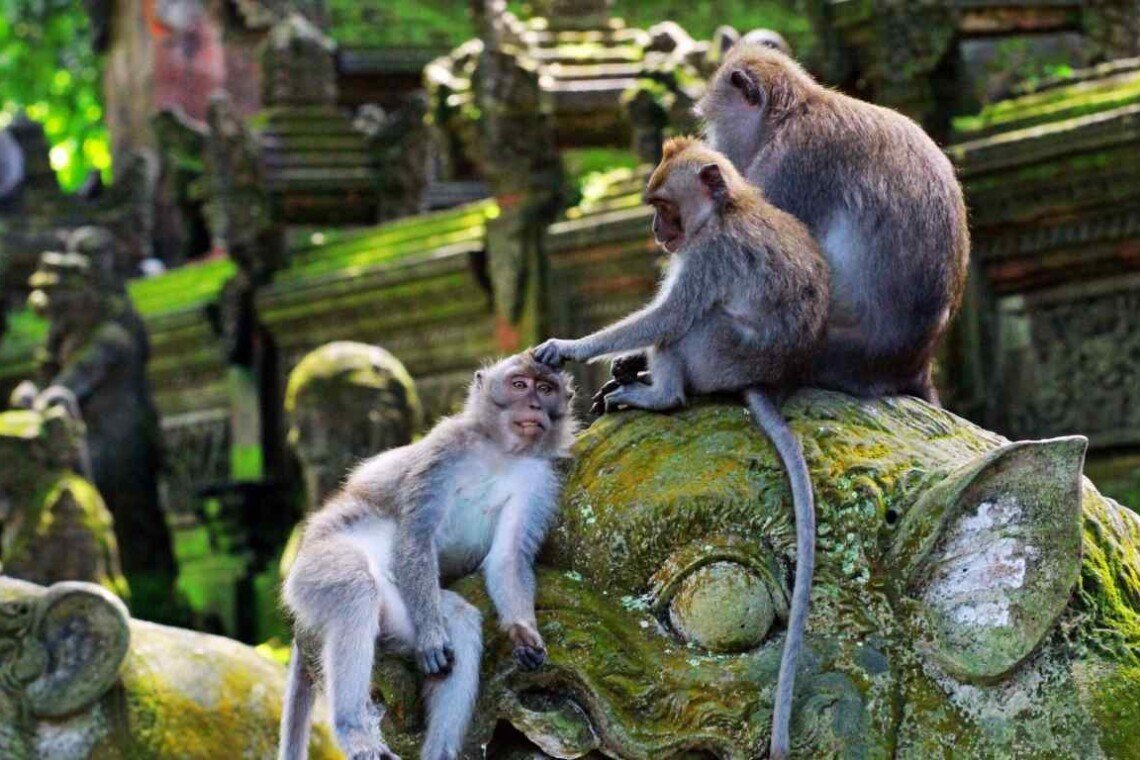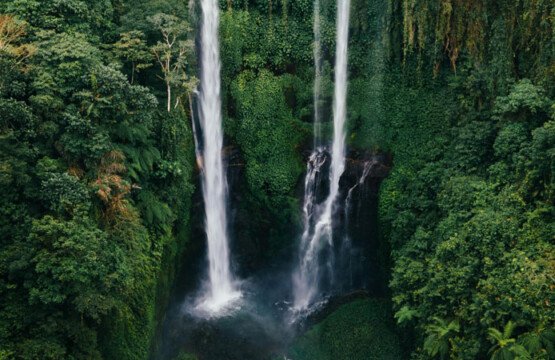🐒 Welcome to the Wild Side of Paradise
Bali, the Island of the Gods, is renowned worldwide for its stunning beaches, ancient temples, and vibrant culture. However, beneath the surface of this tropical paradise lies a rich tapestry of wildlife that captivates nature enthusiasts and casual visitors alike. From the mischievous long-tailed macaques of the Sacred Monkey Forest Sanctuary to the exotic birds that flutter through rice terraces, Bali’s diverse ecosystems offer unforgettable encounters with nature.
🌿 The Sacred Monkey Forest Sanctuary: A Living Temple
🏛️ Where Nature Meets Spirituality
Located in the heart of Ubud, the Sacred Monkey Forest Sanctuary (Mandala Suci Wenara Wana) represents one of Bali’s most fascinating intersections of wildlife conservation and spiritual heritage. This 27-acre sanctuary is home to over 700 Balinese long-tailed macaques, divided into five groups that have established their territories throughout the forest.
The sanctuary isn’t just a wildlife preserve—it’s a living temple complex that houses three ancient Hindu temples dating back to the 14th century. The Pura Dalem Agung Padangtegal, Pura Beji, and Pura Prajapati temples create a mystical atmosphere where visitors can observe the unique relationship between Balinese culture and nature.
🐵 Meet the Residents: Understanding Macaque Behavior
The long-tailed macaques of the sanctuary are intelligent, social creatures with complex hierarchies and behaviors. Adult males can weigh up to 8 kilograms and live for approximately 30 years. These primates are omnivores, feeding on fruits, leaves, bark, stems, and occasionally insects and small animals.
Visitors often witness fascinating social interactions among the macaques, including grooming sessions that strengthen social bonds, playful behavior among juveniles, and territorial displays by dominant males. The monkeys have adapted remarkably well to human presence, though they maintain their wild instincts and social structures.
🚨 Important Safety Tips:
- Keep personal belongings secure—macaques are notorious for grabbing bags, sunglasses, and food
- Maintain a respectful distance and avoid direct eye contact, which can be perceived as threatening
- Never feed the monkeys, as human food can be harmful to their health
- Follow the guidance of local rangers and posted signs
🦅 Beyond the Forest: Bali’s Diverse Wildlife
🐦 Avian Wonders: A Birdwatcher’s Paradise
Bali’s varied landscapes support over 300 bird species, making it a premier destination for birdwatching enthusiasts. The island’s avian diversity ranges from tiny sunbirds to majestic birds of prey.
Notable Species Include:
- Bali Starling (Jalak Bali): Bali’s endemic and critically endangered provincial bird, with its striking white plumage and distinctive blue mask
- Java Kingfisher: A vibrant blue and orange species commonly spotted near water bodies
- Oriental Dwarf Kingfisher: A jewel-like bird with brilliant colors that migrate through Bali
- Brahminy Kite: A large raptor often seen soaring over coastal areas and rice fields
- Yellow-crowned Night Heron: A secretive wader that can be observed in mangrove areas during dawn and dusk
🦎 Reptilian Residents
Bali’s tropical climate provides ideal conditions for various reptile species. The island hosts numerous gecko species that serve as natural pest controllers, while larger reptiles like monitor lizards can be spotted in quieter forest areas.
The reticulated python, Southeast Asia’s longest snake, occasionally makes appearances in rural areas, though encounters are rare. More commonly seen are various species of skinks and small lizards that dart across paths and bask in the tropical sun.
🦋 Butterfly Gardens and Insect Life
The island’s lush vegetation supports an incredible diversity of butterflies and insects. The Bali Butterfly Park in Tabanan showcases over 300 species of butterflies from Indonesia and around the world, while wild species can be observed throughout the island’s gardens and forests.
Notable butterfly species include the striking Troides helena (Common Birdwing), various swallowtails, and the delicate blue morpho butterflies that add splashes of color to the landscape.
🌊 Marine Wildlife: Underwater Treasures
🐠 Coral Reefs and Tropical Fish
Bali’s underwater world rivals its terrestrial wildlife in diversity and beauty. The coral reefs surrounding the island support over 500 species of reef-building corals and more than 3,000 species of fish.
Popular Marine Life Spotting Locations:
- Tulamben: Famous for the USAT Liberty wreck, home to schools of barracuda, giant trevally, and occasional whale sharks
- Menjangan Island: Pristine coral reefs with excellent visibility for observing angelfish, parrotfish, and reef sharks
- Nusa Penida: Renowned for manta ray encounters and the elusive ocean sunfish (Mola mola)
- Amed: Black sand beaches with diverse coral gardens and macro life perfect for underwater photography
🐢 Sea Turtle Conservation
Bali plays a crucial role in sea turtle conservation, with several beaches serving as nesting sites for green turtles, hawksbill turtles, and occasionally leatherback turtles. Conservation efforts have increased dramatically in recent years, with local communities actively participating in protection programs.
🌺 Conservation Efforts and Ecotourism
🛡️ Protecting Paradise
Bali’s approach to wildlife conservation combines traditional Balinese philosophy with modern conservation techniques. The concept of “Tri Hita Karana”—harmony between humans, nature, and the divine—forms the foundation of many conservation initiatives.
Key Conservation Programs:
- Bali Starling Conservation: Intensive breeding and release programs aimed at preventing extinction
- Sea Turtle Protection: Community-based conservation involving local fishermen and beachside communities
- Coral Reef Restoration: Artificial reef programs and coral gardening initiatives
- Mangrove Rehabilitation: Restoring coastal ecosystems that serve as nurseries for marine life
🌱 Responsible Wildlife Tourism
Visitors to Bali can contribute to conservation efforts by choosing responsible tour operators and accommodations that prioritize environmental protection. Many local organizations offer volunteer opportunities for wildlife conservation, from sea turtle monitoring to bird counting expeditions.
Eco-friendly Practices for Visitors:
- Choose tour operators certified by sustainable tourism organizations
- Respect wildlife by maintaining appropriate distances and following local guidelines
- Support local conservation initiatives through donations or volunteer work
- Minimize plastic use and participate in beach cleanup activities
- Stay in eco-certified accommodations that implement environmental protection measures
🗺️ Planning Your Wildlife Adventure
📍 Best Locations for Wildlife Viewing
Central Bali:
- Sacred Monkey Forest Sanctuary, Ubud
- Tegallalang Rice Terraces (for bird watching)
- Sekumpul Waterfall area (for forest wildlife)
West Bali:
- West Bali National Park (Bali Starling habitat)
- Menjangan Island (marine life)
- Bali Butterfly Park, Tabanan
East Bali:
- Tirta Gangga area (dragonflies and water birds)
- Amed coastline (marine life and coral reefs)
- Mount Batur region (highland bird species)
South Bali:
- Serangan Island (sea turtle conservation)
- Sanur Beach (early morning bird watching)
- Benoa Harbor mangroves
🕐 Best Times for Wildlife Viewing
The optimal time for wildlife observation in Bali varies by species and location:
- Early Morning (5:30-7:30 AM): Best for bird watching and observing active wildlife before the heat of the day
- Late Afternoon (4:00-6:00 PM): Excellent for primate observation and butterfly activity
- Dry Season (April-October): Ideal for terrestrial wildlife viewing with clearer paths and better visibility
- Wet Season (November-March): Perfect for observing migratory birds and lush vegetation
🎯 Tips for Memorable Wildlife Encounters
📸 Photography Guidelines
Capturing Bali’s wildlife requires patience, respect, and proper equipment:
- Use telephoto lenses to maintain safe distances
- Avoid using flash photography, which can disturb animals
- Practice ethical wildlife photography by prioritizing animal welfare over the perfect shot
- Consider hiring local guides who understand animal behavior and can predict the best viewing opportunities
🎒 What to Bring
Essential Items:
- Binoculars for bird watching and distant wildlife observation
- Insect repellent (eco-friendly options preferred)
- Comfortable, earth-toned clothing that doesn’t rustle
- Water bottle and snacks for extended viewing sessions
- Small backpack with secure zippers
- Waterproof phone case for marine wildlife viewing
🌟 The Future of Bali’s Wildlife
As Bali continues to develop as a major tourist destination, the balance between economic growth and environmental conservation becomes increasingly critical. Success stories like the gradual recovery of coral reefs in protected areas and the stabilization of some endangered species populations demonstrate that sustainable tourism and conservation can coexist.
Local communities, government initiatives, and international conservation organizations are working together to ensure that future generations can experience the same magical wildlife encounters that make Bali special today. By supporting responsible tourism and conservation efforts, visitors become part of the solution in preserving this tropical paradise.
The wild side of Bali offers experiences that extend far beyond traditional beach vacations. From the playful antics of forest macaques to the graceful dance of manta rays, every wildlife encounter contributes to a deeper understanding and appreciation of this remarkable island’s natural heritage. Whether you’re a dedicated wildlife enthusiast or simply curious about nature, Bali’s diverse ecosystems promise unforgettable memories and a renewed connection with the natural world.
🌺 Experience Bali’s wildlife responsibly, and become a guardian of paradise for future generations to enjoy.










Join The Discussion